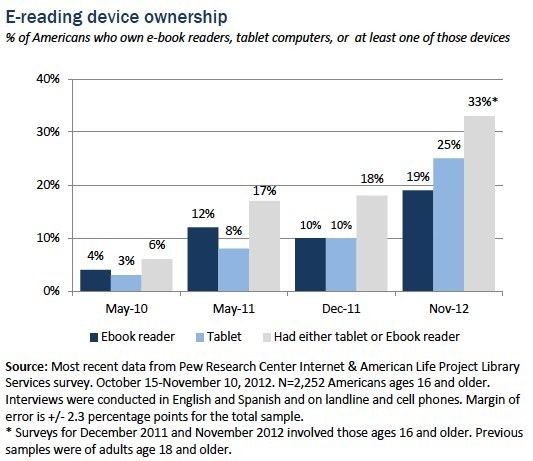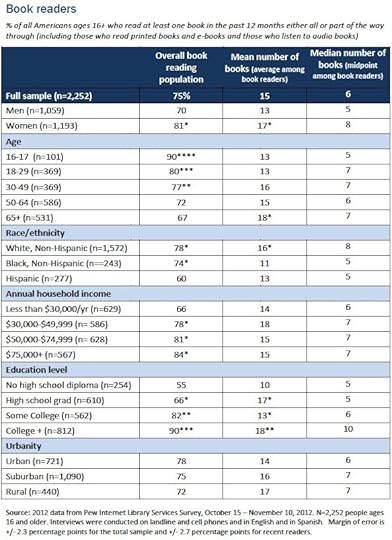2012 By The Numbers (According to Pew)

While we're having a look back at the year in passing, it might be a good time to stop and take stock of the situation. To that end, no doubt, numerous surveys and tallies will soon be forthcoming, but the first of these is this one by Pew Research, detailing current e-readership statistics in the U.S. (follow link to read the full results).
The main trend this year was a shift away from dedicated e-reading devices, such as the eInk Kindles and the Nook Simple Touch, in favor of full-featured tablet devices like the iPad and Kindle Fire. This is hardly surprising, and not entirely enlightening since the comparison is not exactly fair: last year there were far fewer tablet devices available, and thus much less competition for the dedicated devices. But this has been a general trend ever since the first iPad was released, and with every major dedicated device platform now also boasting a tablet version of that same machine, it's only natural that a certain portion of the target audience for e-readers would be drawn off in that direction. After all, you get an e-reader and a load of other features too. Historical sales have clearly shown that a large number of consumers are more than willing to pay extra for added features, even during a recession, oddly enough. And of course, now that we're emerging from that economic dip those numbers are only going to increase.
The chart above shows that over the course of 2012 U.S. ownership of some variety of e-reading tablet device increased overall from 18% to 33%, a significant increase. At the end of 2011 device distribution was split evenly between tablets and dedicated e-readers at around 10% each, while this year dedicated device ownership nearly doubled to 19%, while tablet ownership leaped to 25% - a full quarter of U.S. adults over the age of 16 now own a tablet device of brand or another.
In other findings, the overall number of book readers who now read ebooks increased from 16% to 23%, while at the same time those who read print books declined from 72% to 67% (again, counting only those over the age of 16). Interestingly, that overall number of book readers declined slightly from 78% of the population (over 16), to 75%, meaning that a full quarter of the U.S. population does not read books at all, a sad statistic if there ever was one. But then, with games and movies and apps galore to keep one occupied its hardly any wonder.
There are two additional charts on the Pew Research page that give detailed breakdowns of the demographics within the above numbers, and some of these are quite enlightening as well (useful for authors to know how and where to promote their work).
For example, among ebook readers Urban Females make up the fastest growing segment of the market, with Women leaping from 20% to 31% (+11%), while Men grew from 22% to 30% (+8%), and Urban jumping by +12% from 22% to 34% while Rural only grew by a paltry +3% from 17% to 20%. Likewise, the 16-17 and 30-49 age ranges showed the greatest ebook adoption this year, growing by 15% and 16% respectively, while the 50-64 year old bracket barely edged up by 4%, outpaced only slightly (interestingly enough) by the 18-29 age group at +6% - even the 65+ age bracket fared better at +8%! This is probably an economic issue more than anything, with twenty-somethings mainly struggling just to make ends meet these past few years.

The final chart above provides a breakdown of how many books each demographic faction reads per year, and here again there are some interesting finds. For example, Rural readers tend to consume more books each year (17) than their techno-savvy Urbanites (14), while the 65+ age bracket reads the most overall (18). So writing books for old retired farmers is the way to go, I suppose (Fifty Shades of Grey?). Not surprisingly, women tend to read more than men, at an average of 17 to men's below-average 13 (the average being 15). The mean number of books read per year is 6, meaning that half of book readers read less than this and half read more (the half that read more tend to read considerably more, thus driving the average up). Of the two extremes, 7% of Americans 16 years and older read only a single book this year (and actually confessed it), while 14% read 21 or more books during the past twelve months.
As a personal aside, I only managed to read 34 books this year (so far) - rather an off year for me, as I tend to read a book a week, more or less. But two factors enter into this, one being that I also read a ton of reference materials this year (tutorials and product guides and the like), which I generally do not count among my reading list, and secondly, many of the books I read this year were rather long - my total page count was just shy of 11,000, which is more than last year's 8900 pages, even though I read more books in 2011 (47). If I counted comic books and magazines the number would be vastly higher. I may have inadvertently neglected to add a title or two to my Goodreads page as well, but it's hard to always remember to do so.
So, as you see, these statistics charts must be taken as a very broad average of a much more complex picture. Still, it's worth a glance to have at least a general sense of the world we live in, and where it may be going.

Published on December 27, 2012 16:03
No comments have been added yet.



